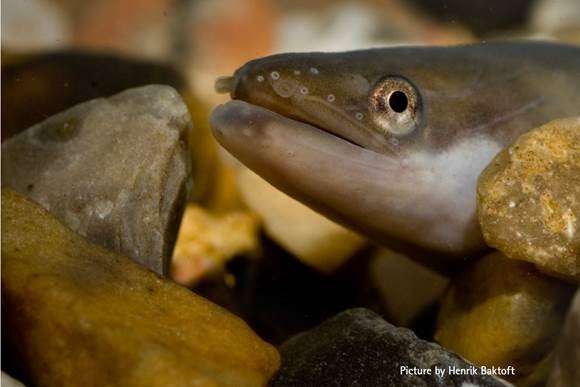New research dispels myth that European Eels are trapped in the Mediterranean

Eels have been tracked more than 2000km from lagoons of the Mediterranean Sea and into the Atlantic Ocean, announced an international team of scientists today. This world first discovery brings to an end a long running debate about whether eels in the Mediterranean were trapped there and unable to find the Straits of Gibraltar and navigate back to the Atlantic.
Their escape to the Atlantic shows that Mediterranean eels are likely to be able to reach the spawning area in the Sargasso Sea and contribute to future generations of eels.
During their migration, eels moved to deep water (up to 800 m) during each day and into shallower water (~350 m) at night-time. This is the same type of behaviour as reported in other studies of eel migration, but it is not clear why eels do this; it might be to regulate temperature, to avoid predators, or for navigation.
When eels reached the Straits of Gibraltar, they abandoned their vertical migration and instead swam to the seabed. There, they took advantage of outward flowing currents to make their migration to the Atlantic easier. After exiting the Straits they resumed their daily vertical migrations.
Better understanding of eel biology will help us to manage their populations across Europe and beyond more effectively. Eels are an important food fish in Europe, often cooked in regional speciality dishes, such as the famous eel and mash shops in London.
Dr David Righton, Principal Cefas Scientist said:
"These new data on the oceanic migrations of European eels show what an amazing species this fish is. Eels are mysterious creatures and hard to study, especially in the deep ocean. Our results are a triumph of technology, logistics and high quality eels. Many scientists have questioned whether eels could escape the Mediterranean because finding the Straits of Gibraltar is like finding a needle in a haystack. All of the eels migrated west after release, and two of them made it more than 2000km from release and into the Atlantic. This is a great achievement for the team, and a significant scientific finding. "
Details
The team attached satellite trackers to 8 eels captured in lagoons of Salses-Leucate and Gruissan, southern France. The effort was led by Elsa Amilhat and a team from the University of Perpignan, with the help of the local fishermen, and in collaboration with researchers from Cefas (UK), DTU-Aqua (Denmark), and the University of Agricultural Sciences (Sweden). The research was funded by the French Ministry of Ecology.
Several months after release, the trackers resurfaced and communicated their final position via satellite, in addition to depth and temperature data collected during the migration. The data were then used to map the migration paths in detail.
Eels undertake large vertical migrations each day, staying in deep water in the daytime and moving into shallower water at night. The mysterious vertical migrations are a common feature of eel behaviour. They might be related to temperature regulation, predator avoidance, or navigation. Scientists are continuing to search for an answer.
European eels spawn in the Sargasso Sea, more than 8000km from the south coast of France. How eels navigate to the Sargasso Sea and many aspects of the migration are shrouded in mystery.
The European eel is an endangered species; the population of European eel has become seriously depleted over the last three decades. Protection of eel populations in countries in Europe is governed by the EU Eel Recovery Plan, and aims to restore the stock of eels to levels last seen 30 years ago.
More information: Elsa Amilhat et al. First evidence of European eels exiting the Mediterranean Sea during their spawning migration, Scientific Reports (2016). DOI: 10.1038/srep21817
Journal information: Scientific Reports
Provided by Centre for Environment, Fisheries and Aquaculture Science (Cefas)





















